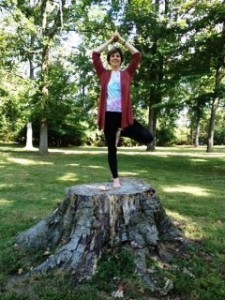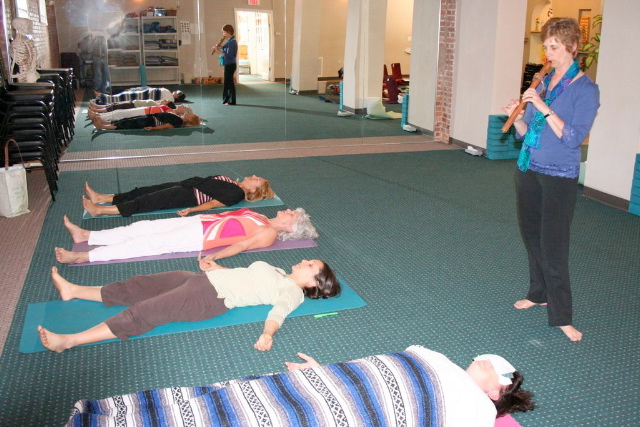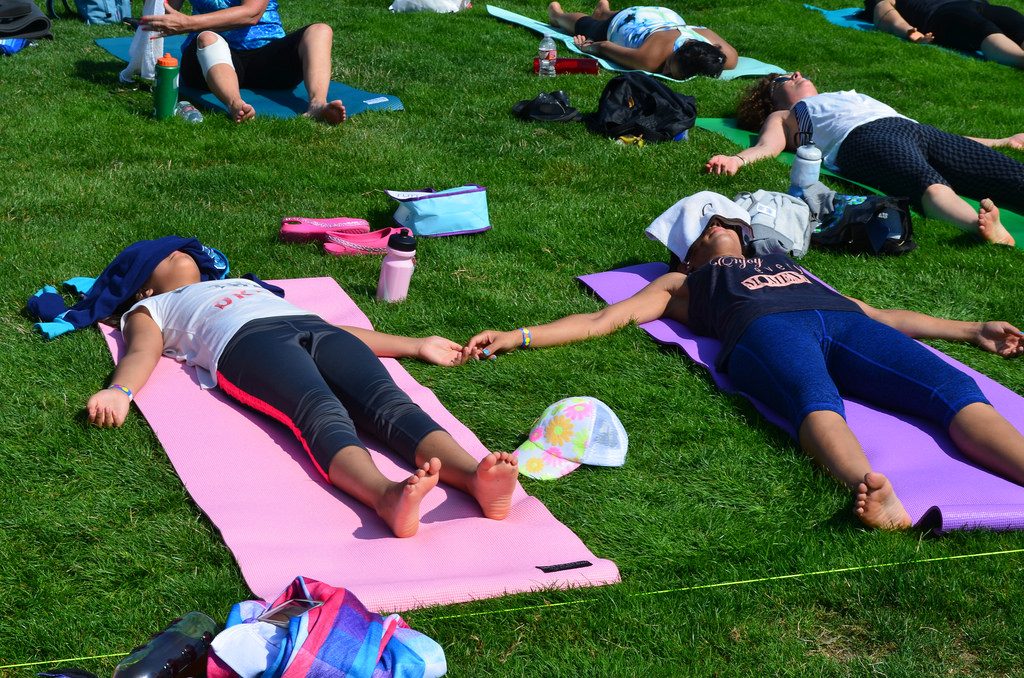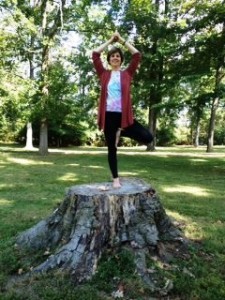Relaxation Techniques
There are several kinds of relaxation techniques that will help return elevated stress levels for you and your clients to an acceptable level. These techniques recognize the mind/body connection, understanding that one cannot be separated from another.
Types of Relaxation Techniques
Breathing is the easiest relaxation technique. Sustained deep breathing will most often can counter the effects of a crisis and the effects of the stress response.
Stretching is a natural. Have the participant concentrate on the place where he or she feels the most tension.
Systematic progressive relaxation involves the intentional tightening and release of the muscles in the body. Each muscle group is attended to individually. Folks will become more aware of where they feel their stress and will eventually be able to address it more easily.
Passive progressive relaxation systematically attends to tension in the various muscle groups of the body. It uses mental images to visualize the draining away of tension from the muscles. It takes some practice before deep relaxation is achieved.
Autogenic relaxation combines deep breathing with images of draining or melting away stress as opposed to tightening and relaxing muscles. It suggests control and mastery of stress and is a good technique for someone who is feeling powerless.
Meditation is somewhat like day dreaming with a purpose. The participant clears his or her mind and then concentrates on a single mental focus.
Guided imagery and visualization takes advantage of the marvelous capacity of the mind to imagine and create sensory images. Participants may be taken to the sea, to the mountains, for a gentle canoe trip. Be careful to choose images that won’t increase the client’s anxiety. Tell the participants that they may open their eyes and come back to reality if the images are uncomfortable.
• Yoga is an ancient system of meditations and exercises.
Begin your relaxation session with a simple breathing exercise. The one below is taken from 30 Scripts for Relaxation Imagery and & Inner Healing, Volume 1, Second Edition, by Julie Lusk. 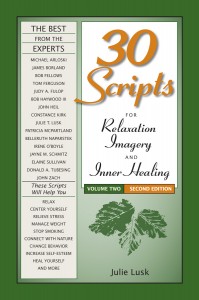
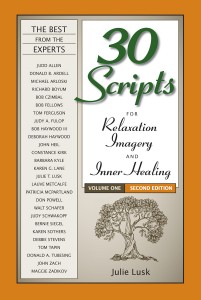
Breathing for Relaxation and Health
By Julie Lusk
Time: 10 minutes
Effective relaxation requires proper breathing. In this script, participants concentrate on their breathing by focusing on what their bodies feel like as they take in deep breaths, hold them briefly, and slowly exhale.
Note: The following information will help your participants understand the importance of slow, deep, rhythmic breathing. You may wish to present it as an introduction before using this script.
Breathe in and out through the nose, not the mouth, unless directed otherwise. The nose filters out pollutants and it moistens and warms the air.
Breathing should be natural, smooth, easy, slow, quiet and complete. Exhaling fully and deeply is the first step to better breathing. It stimulates the functioning of the brain cells and rids the system of stale air. Exhaling helps activate the relaxation response via the parasympathetic nervous system and it lowers the heart rate. Exhaling fully creates ample room for the inhalation. More importantly, taking time for fully inhaling and exhaling slows the breathing rate down. Slowing the breathing rate down causes the brain to get more oxygen. This results in heightened awareness, increased alertness, and calmness. It diffuses anxiety and nervousness.
Oxygenation of the body is essential to physical health and well-being. Breathing abdominally rather than chest breathing, results in a greater transfer of oxygen into the blood for better delivery of nutrients to the tissues. Cells utilize oxygen to create energy. Oxygen is necessary for the development of all organs in the body. Red blood cells are completely renewed every 120 days. The most essential element for accomplishing this reconstruction is not food, but oxygen.
Shallow and irregular breathing can result in the accumulation of bodily wastes and toxins and inadequate functioning of all body organs and tissues. It is also an indicator of stress. Breathing that is slow, smooth, and deep helps alleviate these issues and leads to a clear and alert mind. It also improves the flow of lymph which can improve the immunity system.
Script
Close your eyes…and bring your attention to your breathing…It’s time to begin following the air as it comes in…and as it goes out while breathing through your nose.
Continue feeling your breath each time it comes in…and as it goes out…If your mind begins to wander, just bring it back to feeling and sensing your breath.
Notice if you can feel movement in your belly…your ribs…and your collar-bone while breathing naturally. Take your time.
Pause.
During the next several cycles of breathing, empty your lungs more than usual each time you breathe out. Let all the air out, compressing your stomach to squeeze out all the stale air and carbon dioxide…Letting it all empty out.
Each time you breathe in, take in a nice, full, deep breath and let the air go all the way to the bottom of your lungs. Feel your stomach rise, your chest expand, and the collar-bone area fill.
As you breathe in, your diaphragm expands and massages all the internal organs in the abdominal area…this helps digestion.
As you breathe out, relax…Allowing any tension or knots in your belly to naturally untie…To let go.
Breathing in…Fully and completely.
Breathing out…Letting it all go…relaxing more and more…Breathing heals you…calms you…it’s soothing.
When breathing in fully and completely. Oxygen is entering your blood stream, and nourishes all your organs and cells. It protects you.
Breathing out releases metabolic waste and toxins. Your breath is cleansing you…healing you.
Let’s use the breath in another way and take advantage of the mind-body connection.
Leaders note: Use one or more of the following, depending on the group’s needs or time available. Give participants enough time to experience this.
If you wish, imagine exhaling confusion…and inhaling clarity.
Imagine exhaling darkness…and inhaling light.
Imagine exhaling fear…and inhaling love.
Exhaling pain…and inhaling relief.
Exhaling anxiety…and inhaling peace.
Exhaling selfishness…and inhaling generosity.
Exhaling guilt…and inhaling forgiveness.
You may continue on with a guided meditation. If you choose to end here, repeat the following until everyone is alert.
Stretch and open your eyes, feeling refreshed, rejuvenated, alert, and fully alive.
Click here for a printable version.
Sun Meditation for Healing and Relaxation
By Judy Fulop and Julie Lusk
Time: 10 minutes
In this script, participants experience the healing power and energy of the sun as they imagine it warming and relaxing them.
Script
Please close your eyes and take some time to go within yourself to settle your body, mind, and heart. Feel free to use whatever method works best for you. For example, it may be focusing on your breath, meditating, stretching your body mindfully, or using a sound, word, image, or a phrase as a mantra to become centered…Take your time…allowing yourself to become more and more at ease with yourself.
Pause
Allow yourself to become as relaxed and comfortable as you can…Let your body feel supported by the ground underneath you.
Slowly begin to see or feel yourself lying in a grassy meadow with the sun shining it’s golden rays gently upon you…Let yourself soak in these warm rays …taking in the healing power and life giving energy of the sunshine.
This magnificent ball of light has been a sustaining source of energy for millions of years and will be an energy source for millions of years to come…This ancient sun is the same sun which shined down upon the dinosaurs…upon the Egyptians while they built the pyramids…and it now shines upon the earth and all the other planets in our solar system and will continued to do so.
As the sun’s rays gently touch your skin, allow yourself to feel the warmth and energy flow slowly through your body…pulsing through your bones…sending healing light to your organs…flowing to your tissues…recharging every system…and now settling into your innermost being…your heart center.
Sense your heart center glowing with this radiant energy. If you wish, give it a color…
Take a few moments to allow this warm and healing energy to reach your innermost being…physically…emotionally…mentally…and spiritually.
Pause for 30 seconds
As this healing energy grows and expands, allow yourself to see, feel, and sense this energy surrounding your being…growing and growing…Allow this energy to further fill this room…this building…surrounding this town…spreading throughout our state…to our country…and out into the worlds…and finally throughout the universe…reaching and touching and blessing all.
Pause for 30 seconds
You may share this healing energy and power with anyone you’re aware of right now…Mentally ask them if they are willing to receive this healing energy…If they are…send this source of healing energy to them…giving them the time they need to take in this energy and make it theirs in their own heart center.
Pause for 30 seconds
Now take your attention back to your own heart center…Find a safe place within you to keep this healing and powerful energy…a place to keep it protected and within your reach…Give yourself permission to get in touch with this energy whenever you wish.
With the warmth of this energy in your being, begin stretching, wiggling, and moving…Slowly open your eyes, feeling alive, refreshed, keenly alert, and completely healthy.
Repeat the above instructions until everyone is alert.
Click here for a printable version.
Julie Lusk, M.Ed., RYT, has dedicated her efforts to helping others attain stress relief, wellness and holistic health through yoga, meditation and guided imagery.
Julie has a Masters in Education from Virginia Tech. She is a National Certified Counselor and Registered/Certified Yoga Teacher. Julie was a Licensed Professional Counselor in Virginia for 20 years.
Julie has taught yoga since 1977 and is certified to teach a variety of styles ranging from gentle to vigorous yoga. Yoga Alliance awarded her the highest credential available. She teaches locally, nationally and is a teacher trainer.
Her previous careers include Regional Director, Mercy Holistic Health and Wellness Centers (Cincinnati, OH), Assistant Dean of Students of Roanoke College (Salem, VA) and Director of Health Management, Lewis-Gale Clinic (Salem, VA).
Julie’s volunteer efforts in community health promotion earned recognition from the US Surgeon General and the Governor of Virginia.
Julie is available as a business and conference speaker and consultant to groups and individuals. Her books, recordings and other materials are plentiful.
Link to Julie’s website: www.wholesomeresources.com
Check the catalog for relaxation techniques on CD.
Like this:
Like Loading...
